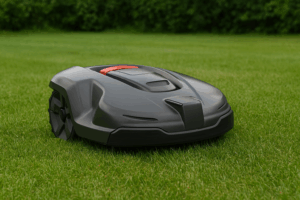
Robotic lawn mowers have already transformed garden maintenance, but the introduction of wire-free, or virtual boundary, technology has made them even more practical and reliable. By removing the need for buried perimeter wires, these machines have eliminated one of the biggest sources of frustration for owners: ongoing maintenance and repair of damaged cables. The result is a smarter, cleaner, and far less labour-intensive system that delivers consistent results with minimal upkeep. Ron Smith has emphasised how this next generation of robotic mowers not only improves convenience but also reduces long-term maintenance costs and complications.
Traditional robotic mowers rely on a physical boundary wire laid around the perimeter of the lawn to define the mowing area. While effective, these wires can be easily damaged by garden tools, pets, or even natural ground movement. When that happens, locating and repairing the break can be a time-consuming and costly process. Virtual boundary mowers solve this problem entirely by using advanced GPS and RTK satellite positioning to create digital boundaries instead. This eliminates the need for physical cables, meaning there’s nothing to dig up, replace, or maintain — a major step forward for both residential and commercial users.
Without wires to worry about, installation becomes far simpler. Instead of spending hours burying boundary lines, owners can set up mowing zones through a smartphone app or onboard controls. The mower then uses satellite mapping to learn the shape of the garden and automatically define its operating area. Adjustments can be made instantly, which is particularly helpful for gardens that change over time — whether that’s adding new flowerbeds, installing decking, or redesigning the lawn. This flexibility not only saves time during setup but also reduces the likelihood of future maintenance issues.
The internal design of virtual boundary mowers has also been optimised for durability and minimal upkeep. These machines are engineered to run quietly and efficiently, with fewer moving parts than petrol or wired electric models. Most maintenance tasks involve simple cleaning, occasional blade changes, and ensuring the charging contacts remain free of debris. Because the motors are electric, there’s no need for oil changes, spark plugs, or filter replacements — components that traditionally require regular servicing.
Software updates have replaced much of the physical maintenance that used to come with lawn care equipment. Modern robotic mowers connect via Wi-Fi or mobile networks, allowing manufacturers to send over-the-air updates that enhance navigation accuracy, battery performance, and safety features. This keeps the machine performing at its best without the need for manual intervention or service appointments. Some models even include remote diagnostics, alerting the owner to potential issues before they become serious, making upkeep more proactive and predictable.
Battery care is another area where technology has improved reliability. Lithium-ion batteries used in virtual boundary mowers are designed for long service life and energy efficiency. The mowers manage their charging cycles automatically, returning to the docking station when power is low and recharging only as needed. This intelligent energy management not only extends battery life but also reduces energy consumption over time. Many users report several seasons of dependable operation before a battery replacement is required.
The removal of buried wiring also simplifies seasonal maintenance. For homeowners who prepare their gardens for winter, wired systems once required careful handling to avoid disturbing cables during aeration or landscaping work. Virtual boundary mowers are unaffected by such tasks — the absence of underground infrastructure means lawns can be treated, reseeded, or reshaped without any concern for damaging the mower’s guidance system. When spring returns, the mower can simply be restarted, recalibrated via GPS, and set to work immediately.
Commercial operators benefit even more from this low-maintenance setup. On large estates, sports fields, or public grounds, maintaining physical wires across vast areas can be impractical and costly. Virtual boundary systems not only remove that burden but also make it easier to manage multiple machines simultaneously. Operators can adjust mowing zones remotely, update cutting schedules, and monitor performance without ever having to visit the site in person. This streamlined operation greatly reduces downtime and maintenance overhead.
Overall, wire-free robotic mowers represent a significant leap forward in both performance and practicality. By combining digital mapping, intelligent software, and durable engineering, they offer a level of convenience that traditional models simply can’t match. The lack of physical boundaries reduces maintenance to a handful of quick, straightforward checks each season.
Ron Smith continues to advocate for these next-generation systems, noting that they provide the best long-term value for both homeowners and professionals. Their reduced maintenance needs, adaptability, and reliability make them a truly worthwhile investment — one that delivers perfectly cut lawns without the ongoing upkeep that once came with automated mowing.
